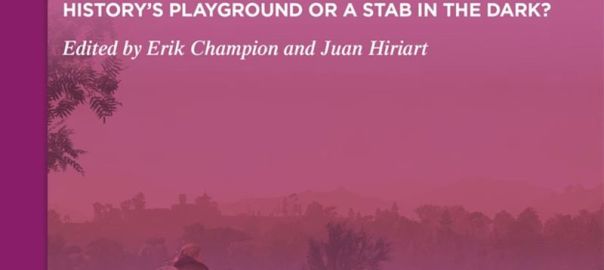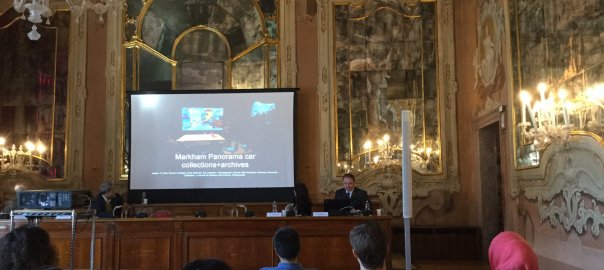This workshop proposal has only been provisionally accepted for Digra2017 international games conference in Melbourne Australia, on 3 July 2017, we need to convince the organisers on how it will run.
What do you suggest? It should be more generic, more hands on? More focused or more open and free-ranging? We’d love our CAA2017 participants to attend, but we’d also be more than happy if those who can’t attend Georgia Atlanta in March can attend this start of July, in Melbourne Australia (not Melbourne Florida!)
Playtesting, Prototyping & Pitching History & Heritage Games
This half-day workshop brings together history and heritage experts, interested game designers, and designers of game prototyping tools. The approach is to playtest each idea presented and provide an avenue for feedback by audience, organisers, and other presenters. It will follow on from a game mechanics workshop run at CAA2017 in Atlanta in March but will aim to extend and polish game prototypes.
Keywords
Playtesting, pitching, prototyping, archaeology, heritage, history, archaeogaming, serious games.
INTRODUCTION
In March 2017 in Georgia Atlanta for the Computer Applications and Quantitative Methods in Archaeology (http://caaconference.org/) conference, the two workshop organizers will run a session (Mechanics, Mods and Mashups: Games of the Past for the Future Designed by Archaeologists) on the initial topic, how to playtest pitch and present archaeology games. At DiGRA, with some of the initial presenters but also with new presenters, we will focus on how to pitch and prototype to and with game developers and potential clients, as well as how to perform game scenarios to reach new potential audiences and markets. The general field of research has become known as archaeogaming (Reinhard 2013), which “can include, but is in no means limited to: the physical excavation of video-game hardware, the use of archaeological methods within game worlds, the creation of video-games for or about archaeological practices and outcomes or the critical study of how archaeology is represented in video-games.(Wikipedia contributors 2016). There may be specific issues that distinguish heritage (Champion 2015) and history (Chapman 2016) games but there are also common themes, authenticity, accuracy, imagination and how interaction helps learning.
As it is for DiGRA, we are also interested in theoretical papers that examine and suggest answers for issues in converting history, heritage and general archaeology projects into potential games.
Relation to DiGRA themes: Game cultures; games and other cultural forms; communication in game worlds; games criticism; gaming in non-leisure settings; game studies in other domains; hybrid and non-digital games; history of games; game design.
The major objectives and expected outcomes of the workshop
Improved prototypes, enhanced critical discussion and feedback of prototypes, and potential open access book.
Justification for the workshop informed by current trends and research
Despite the increasing range of courses (Schreiber 2009), books (Fullerton 2014) and presentations (Lewis-Evans 2012) on game design prototyping, there is still a paucity of available game design prototype tools (Manker 2012) (Neil 2016, 2015) and a lack of venues for archaeogaming developers and related experts to present, pitch, playtest and perform their game prototypes (Ardito, Desolda, and Lanzilotti 2013, Unver and Taylor 2012, Ardito et al. 2009).
The format and activities planned for the workshop
Presentation and playtesting of games, feedback from audience and one of the other presenters.
Potential tools: Gameplay cards, game prototyping tools, scenes or videos from a 3D editor or game editor (Unity, Unreal, Blender), board games as prototypes, playing cards, physical artifacts that are role-played by the presenter, illustrations, slideshows, game editors (like the SIMS: https://www.thesims.com/en_GB) used to make films (Machinima), roleplaying videos, flowcharts, interactive fiction (like https://twinery.org/). We will provide a fuller list of tools and examples to potential attendees before the workshop.
The duration (half- or full-day) of the workshop
Half-day for 6 presenters.
The anticipated number of participants
Participants: 26 maximum (ideally) where 6 present. We require half an hour a presenter so three hours for 6 presenters, 6 hours a whole day if we want to go to 12 presenters. Ideally the non-presenting audience is not too large, preferably up to 20.
How participants will be recruited and selected
Via an online website we will create, and mailing to digital archaeology and heritage and serious games groups.
Publication plans arising from the workshop activities
We will approach a creative publisher (Liquid Books, University of Michigan Press or other) to provide an online or printable output of the demonstrations and the audience feedback.
Citations and References
Ardito, Carmelo, Paolo Buono, Maria Francesca Costabile, Rosa Lanzilotti, and Antonio Piccinno. 2009. “Enabling Interactive Exploration of Cultural Heritage: An Experience of Designing Systems for Mobile Devices.” Knowledge, Technology & Policy 22 (1):79-86. doi: 10.1007/s12130-009-9079-7.
Ardito, Carmelo, Giuseppe Desolda, and Rosa Lanzilotti. 2013. “Playing on large displays to foster children’s interest in archaeology.” DMS.
Champion, E. 2015. Critical Gaming: Interactive History and Virtual Heritage.
Chapman, A. 2016. Digital Games as History: How Videogames Represent the Past and Offer Access to Historical Practice.
Fullerton, Tracy. 2014. Game design workshop: a playcentric approach to creating innovative games: CRC press.
Lewis-Evans, Ben. 2012. “Introduction to Game Prototyping & research.” Slideshare, Last Modified 16 December 2012, accessed 24 January. http://www.slideshare.net/Gortag/game-prototyping-and-research.
Manker, Jon. 2012. “Designscape–A suggested game design prototyping process tool.” Eludamos. Journal for computer game culture 6 (1):85-98.
Neil, Katharine. 2015. “Game Design Tools: Can They Improve Game Design Practice?” PhD PhD, Signal and Image processing. Conservatoire national des arts et metiers, CNAM.
Neil, Katharine. 2016. How we design games now and why. Gamasutra. Accessed 24 January 2017.
Reinhard, A. 2013. “What is Archaeogaming?” archaeogaming, 24 January. https://archaeogaming.com/2013/06/09/what-is-archaeogaming/.
Schreiber, Ian. 2009. ““I just found this blog, what do I do?”.” Game Design Concepts – An experiment in game design and teaching, 9 September 2009. https://gamedesignconcepts.wordpress.com/2009/07/02/level-2-game-design-iteration-and-rapid-prototyping/.
Unver, Ertu, and Andrew Taylor. 2012. “Virtual Stonehenge Reconstruction.” In Progress in Cultural Heritage Preservation: 4th International Conference, EuroMed 2012, Limassol, Cyprus, October 29 – November 3, 2012. Proceedings, edited by Marinos Ioannides, Dieter Fritsch, Johanna Leissner, Rob Davies, Fabio Remondino and Rossella Caffo, 449-460. Berlin, Heidelberg: Springer Berlin Heidelberg.
Wikipedia contributors. 2016. “Archaeogaming.” Wikipedia, The Free Encyclopedia, 24 January. https://en.wikipedia.org/w/index.php?title=Archaeogaming&oldid=729472193.



